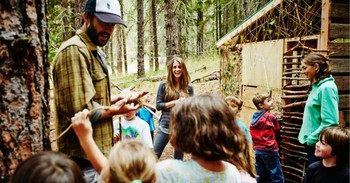
How Swiss Reformed Christians and Anabaptists Repented Together to Address a Historic Rupture
The years between 1520 and 1550 were some of the most tumultuous in history. The course of Western civilization was dramatically altered. During this period, the Swiss Reformation exploded and sent forth waves that eventually reached much of the world, including a profound influence on the development of America. The first key center for Swiss reform was the city of Zurich under its brilliant and colorful leader and pastor Ulrich Zwingli. His sermons were geared to the common person and so emotionally moving that one hearer said he "felt as if lifted up by the hair and suspended in space."
Zwingli had searched the Scriptures and questioned major teachings of the church of the Middle Ages. He rapidly instituted sweeping reforms in the early 1520s. The accepted ways and world views of the day were challenged and changed. Inevitably, conflict erupted.
A major crisis for Zwingli developed from among his most gifted students. They rejected infant baptism as unbiblical and rebaptized themselves as adults. For this they were called "Anabaptists." The city council held public debate and rejected their views. The Anabaptists were ordered to conform or get out.
But they would neither submit nor leave. So on January 5, 1527, the city Council drowned Anabaptist leader Felix Manz. "Against the waters of baptism he sinned," they said, "so by water shall he die." He was only the first of this new movement to be killed. A wave of persecution against the Anabaptists ensued that lasted for generations, and it came from all directions‚-- Catholics, Lutherans, Reformed, all considered them deviant and unwelcome.
But the Anabaptist movement survived and spread despite losing many of its best leaders to persecution. In America, Mennonites and Amish are among their most well-known descendants.
Now a remarkable chapter in Christian history is unfolding as almost 500 years after the first rupture, the descendants of both the persecutors and the persecuted are seeking reconciliation and restored fellowship. In the process, they are learning from one another. We present here the first-hand experience and reflections of one who has been part of the reconciliation process. Pastor Charles A. Ness, our neighbor here at Christian History Institute, has kept us informed about this extraordinary process. Here are his observations on what is happening and his thoughts on what it means for him and his fellow Mennonites.
From Pastor Ness: Our Painful Past
A May 1-4, 2003 conference in Winterthur, Switzerland, called "Heal Our Land," was a time of reconciliation for our churches. During the Reformation in the 16th century, there was a division between the State Reformed church in Switzerland and a group known as the Anabaptists. Some of the issues involved baptism of adults rather than children, separation of church and state, love to all people, including enemies, and the authority of Scripture. As a result the state church persecuted thousands of Anabaptists by torture and martyrdom. Many of them fled the country, and some later settled in America, where they became known as Mennonites and Amish.
A Swiss Reformed pastor for thirty years has carried a burden for reconciliation between these two groups. Geri Keller, founder of a parachurch ministry called Stiftung Schleife, organized the conference. Many Anabaptists attended from Switzerland, Germany, France, Austria, Belgium and other parts of Europe, as well as Canada. The Swiss Reformed church was represented by approximately forty Reformed pastors and many lay people, who joined together for the four-day conference. Forty Amish from Montana and Idaho and seventeen Mennonites from the Lancaster and Franconia, PA areas were invited to participate in the conference. My wife Janet and I attended, representing Mennonites from the Franconia Mennonite Conference area. The total number of persons attending the conference exceeded 800.
Both Sides Repented
It is hard to describe how the Lord moved in the conference. Emotions ranged from weeping to laughter in the times of confession and celebration. Speakers representing the State Reformed church acknowledged the wrongs done to the Anabaptists and asked for forgiveness. The Anabaptists repented of attitudes toward the State Church and sought freedom from the effects of the persecution on us. That the time was right for reconciliation was confirmed by the powerful presence of the Lord upon the conference. It did seem that the hearts of the fathers (Reformed Church) and sons (Anabaptist) were being reconciled.
It was more than just talk, however, since there were times when symbols spoke louder than words. Thirty Reformed pastors, dressed in their clerical robes, publicly washed the feet of every Amish person who attended. These same pastors later knelt down on stage before the American Mennonite and Amish leaders and tearfully asked for and received a verbal affirmation of forgiveness from every Anabaptist leader and his wife. The Church Council President of the Grossmünster Church in Zurich, where Zwingli had been pastor and where many of the first Anabaptists were found guilty by the church and were executed, read a statement of apology to the Amish group. Following his apology, for the first time in history, an Anabaptist Amish Bishop, Bishop Ben Girod preached from the Reformed church pulpit in the Grossmünster.
Inward Pain, But Then Release
A joint service was held in the State Church in Baretswil, with the pastor acknowledging the wrongs done to the Anabaptists and the Mennonite leaders praying prayers of blessing over him and the church. Baretswil is the town near the "Anabaptist Cave," where early Anabaptists met in secret to worship. This was especially meaningful, since both my wife and I have a common ancestor from that area who was persecuted and imprisoned for his faith. To worship in the church responsible for his persecution was a bittersweet experience. I felt inward pain as I was there, but then a release as I prayed a blessing over the church. From there we went to the cave, where we joyfully sang with a group of people that included Reformed brothers and sisters.
On Tuesday, after the conference, Amish and Mennonites gathered at the Trachselwald castle, in the Emmental Valley, where many Anabaptists had been incarcerated and tortured before being taken to execution. A government official of the region, Markus Grossenbacher, publicly asked forgiveness on behalf of the government of the Trachselwald region for the persecutions done there against the Anabaptists. As he spoke I felt a breaking of strongholds. Later, in Schaffhausen, Sabine Aschmann, a Reformed State Church pastor, gave her family's rare copy of a Froschauer Bible as a gift of restitution to the Lancaster Mennonites. The Bible, printed by Sabine's family in 1538 for Anabaptists, had been confiscated during the persecution years.
There were also times of blessing and celebration as Amish, Mennonites and others joined hands to sing and dance around the meeting hall, waving flags and shouting praise to God.
I believe that in the days ahead we will see the effects of this conference as the church moves forward with renewed vision and power.
It was a spiritual pilgrimage for me. I enjoy history and have studied Anabaptist history, but this conference touched me deeply. The few times I spoke or prayed publicly, I was overcome with emotion. There was an inward pain that I cannot fully explain. At one point Reformed pastors were on their knees before Mennonite leaders and asking forgiveness for the persecution to our ancestors. I was thinking, this is no small thing they ask for, and who am I to stand in the gap and answer for the Anabaptists in history and in the present. It was an awesome and humbling privilege to be among those invited to participate.
The Reformed pastors are serious about reconciliation. They have a burden for the health of their church and believe that reconciliation with the Anabaptists is an important part of their renewal. I lost count of how many came to my wife Janet and me in tears, asking forgiveness for the things done to our ancestors. They also made a financial sacrifice to have the Mennonites and Amish attend the conference. The Swiss attending the conference gave an offering of 15 thousand dollars for youth work among the various groups represented in the conference. A flag carried to every canton in Switzerland by prayer teams was sent to America with us to symbolize their desire for renewal among Mennonites here. Many of these Reformed pastors struggle with baptism of adults. That, of course, takes us back to the basic issue that divided us in the first place. Several confessed to baptizing adults in secret because of fear of their church leaders. One tearfully asked us, "Will you stand with us if we are driven out of our church?" I saw the same conflict of conscience that the Anabaptists had between obeying the church rules, and at the same time being faithful to their understanding of the Scriptures, both historically and in the present.
This conference also made me realize more than ever how we need to address the divisions within our own denomination here in our country. How might the Lord work reconciliation here in America? Various Mennonite groups do not worship together, although we claim a common faith tradition. What about relationships between Anabaptists of today and other denominations? Can we respectfully reach out to other faith traditions and affirm our common faith in Christ without imposing our beliefs upon each other?
I pray this conference will help to bring healing to the Mennonite Church so that God can visit us with renewal. While we cannot change the past, we can change the way we think of ourselves in the present, and create a new identity for the future. The prophet Samuel called Israel to put away the false gods and worship God alone. In a similar way I believe as a Mennonite church we need to overcome the impact of persecution that still affects us today. These strongholds (patterns of thinking) of fear of man, self-righteousness, materialism, control, avoidance of conflict, and pride in tradition have hindered spiritual vibrancy and church growth. The original Anabaptist beliefs in Scripture's simple yet bold proclamation, the power of the Holy Spirit, prophetic ministry, radical discipleship, and a passion for the unchurched need to be recaptured and practiced. I pray that we might be found faithful.
A memorial plaque at the Limmat River commemorates the Anabaptists executed in this conflict: Here in the middle of the Limmat River from a fishing platform, Felix Manz and five other Anabaptists were drowned between 1527 and 1532 during the Reformation. The last Anabaptist to be executed in Zurich was Hand Landis in 1614. Swiss Reformed pastor Geri Keller, Menonnite pastor Charles Ness, and Amish Bishop Ben Girod Left: Zwingli's Grossmunster Church in Zurich where many of the first Anabaptists were tried.
©2006 by Christian History Institute. Prepared by Ken Curtis, Ph.D., and Charles A. Ness, with Joe Thomas, Ph.D., Tracey L. Craig, and Ann Snyder. Photo credits Charles A. Ness and Chi Archives.
Photo credit: Wikipedia







